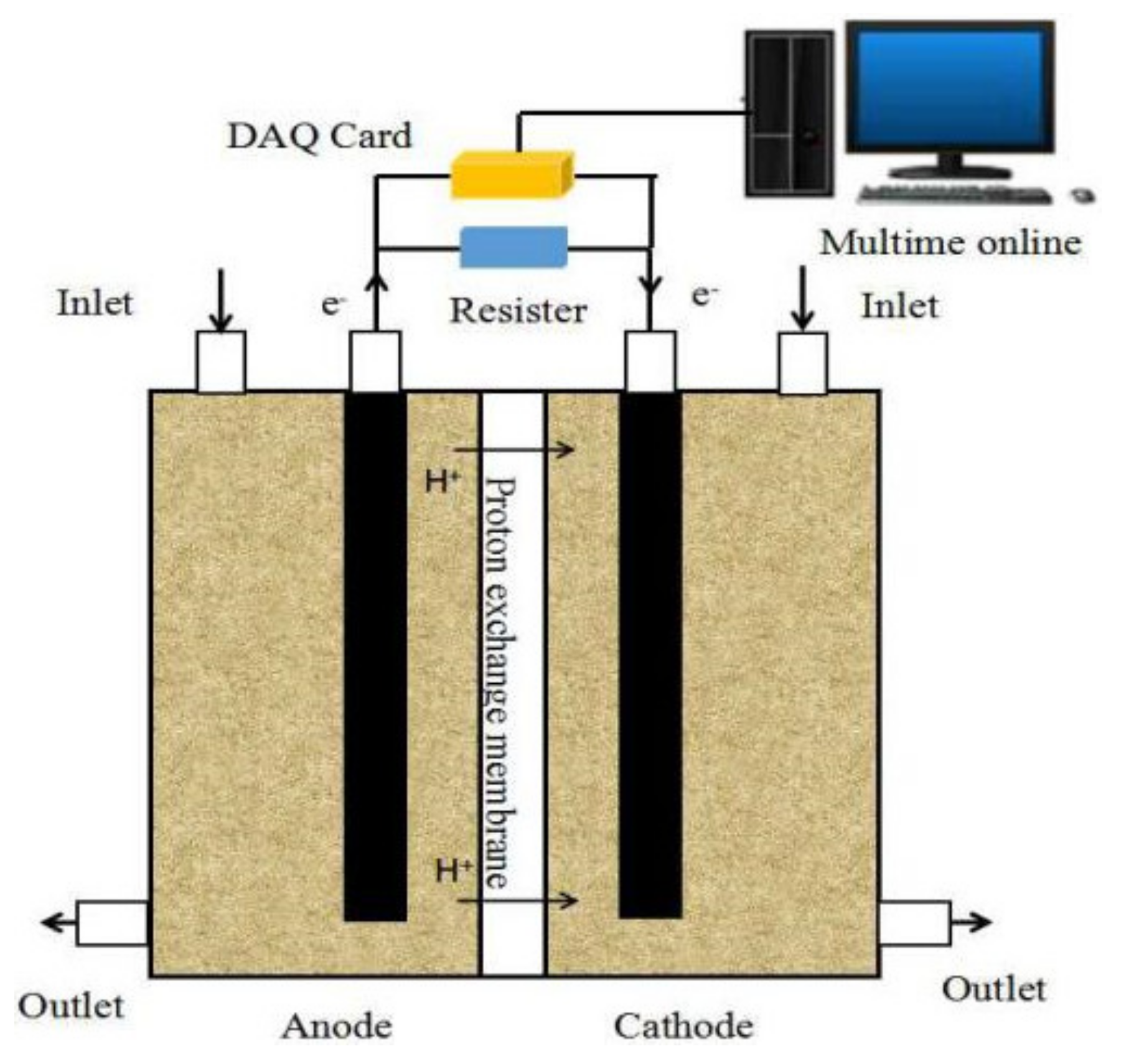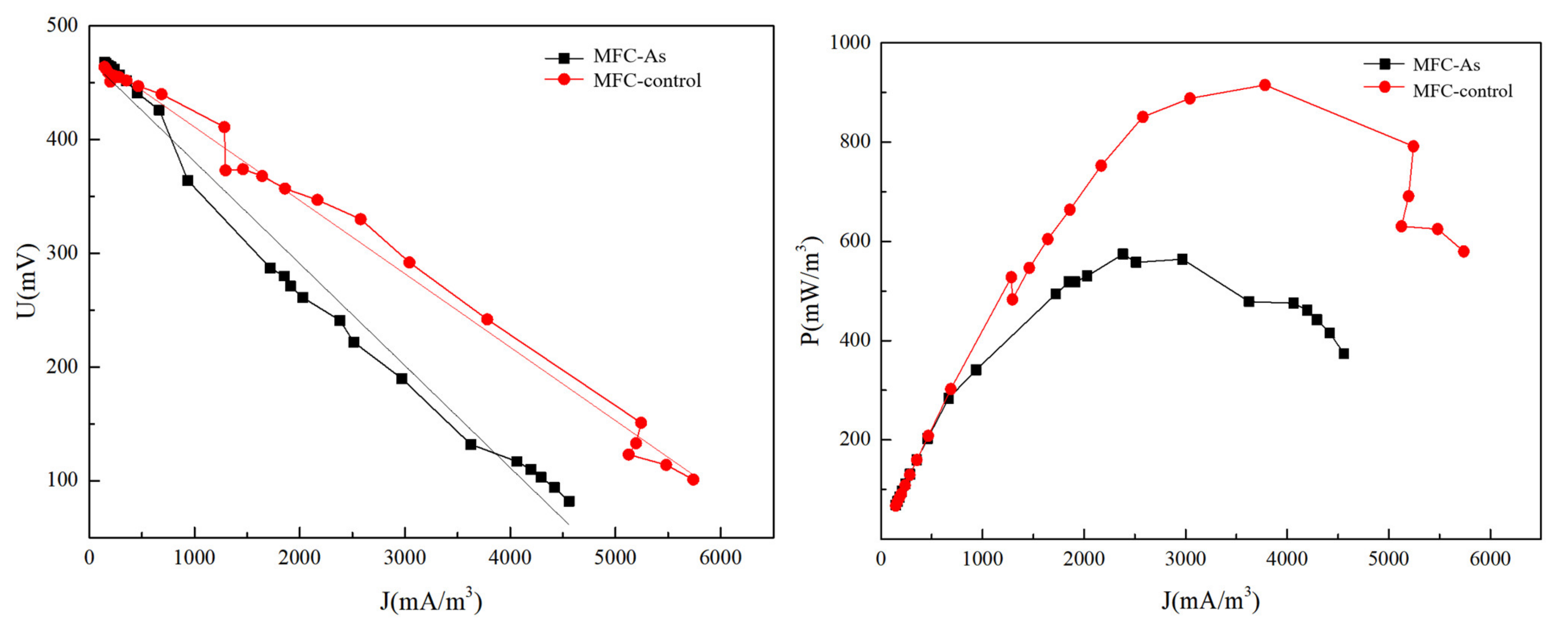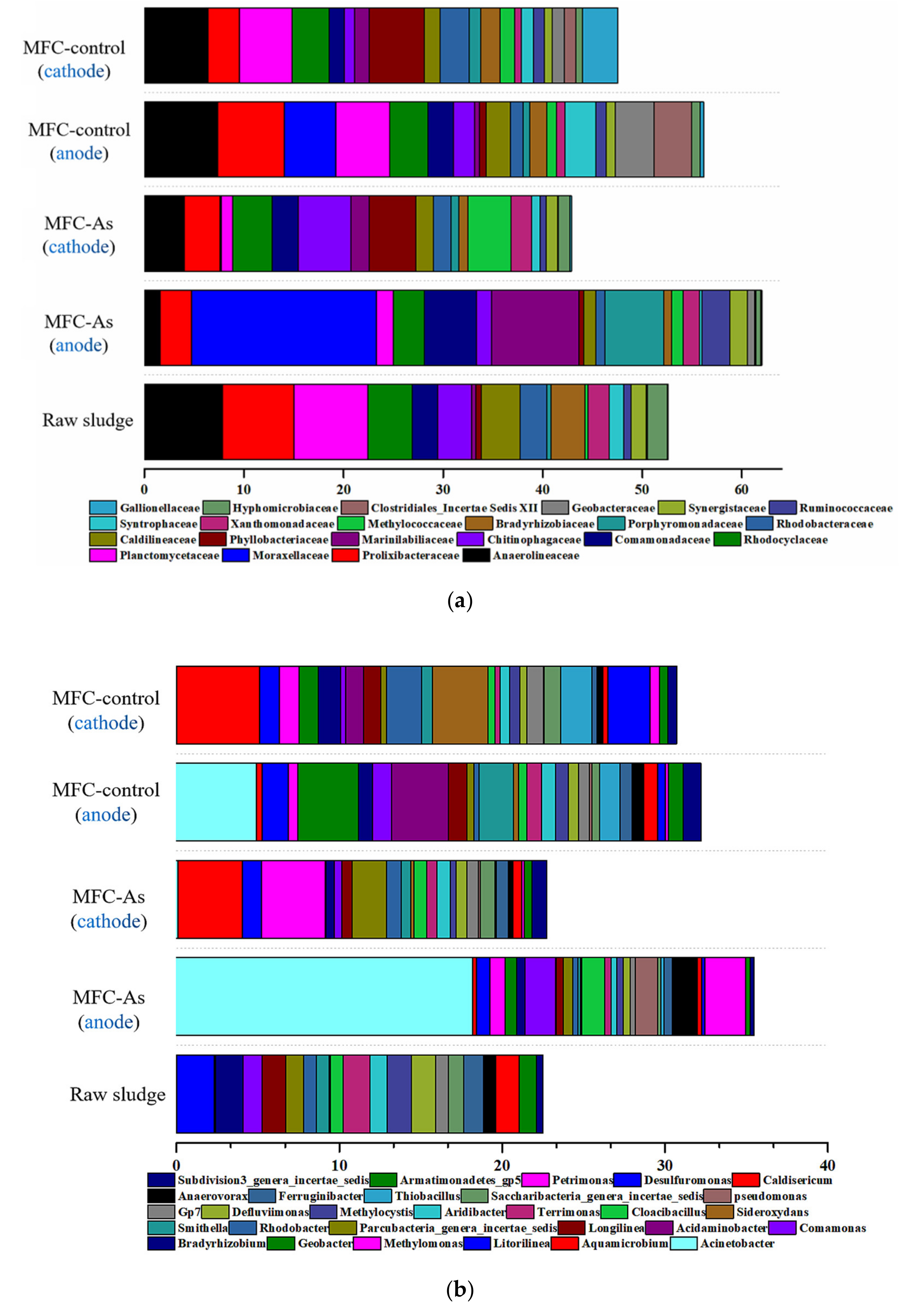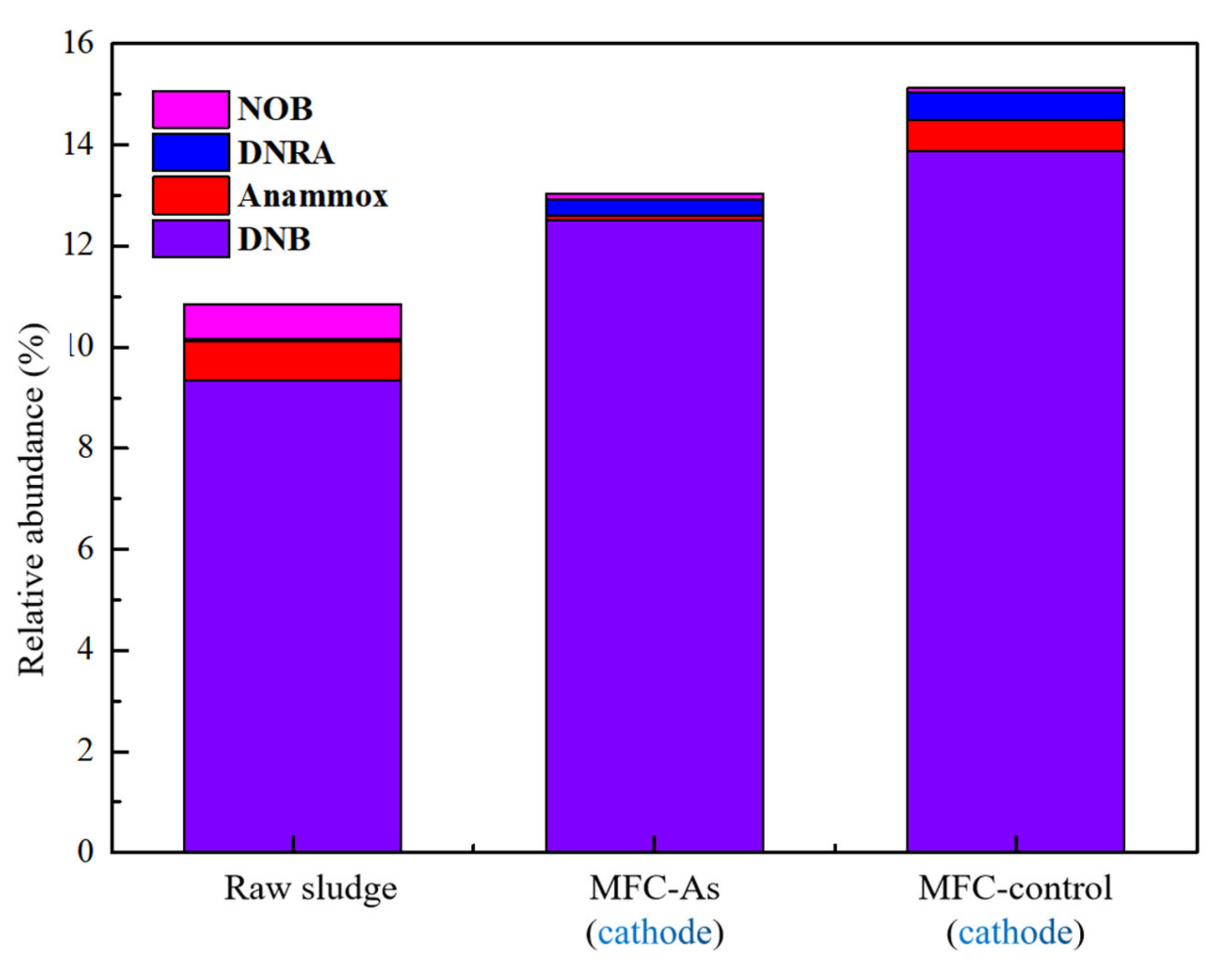Simultaneous Removal of Trivalent Arsenic and Nitrate Using Microbial Fuel Cells
Abstract
1. Introduction
2. Experimental
2.1. MFC Construction and Operating Conditions
2.2. MFC Testing and Chemical Analysis
2.3. Amplification of 16S rRNA Genes, Sequencing and Sequence Analyses
3. Results and Discussion
3.1. Electrical Performance
3.2. Removal of As(III) and Nitrate
3.2.1. Detoxification Effect of Arsenic in MFC-As
3.2.2. Effect on Nitrate Degradation
3.3. Characterization of Microbial Communities
3.3.1. Microbial Community Diversity Analysis
3.3.2. Analysis of the Structural Composition of Microbial Community
4. Conclusions
Author Contributions
Funding
Institutional Review Board Statement
Informed Consent Statement
Data Availability Statement
Acknowledgments
Conflicts of Interest
References
- Li, H.; Chen, W.X.; Wong, H.M. Arbuscular mycorrhizal fungi reduced the ratios of inorganic/organic arsenic in rice grains. Chemosphere 2016, 145, 224–230. [Google Scholar] [CrossRef]
- Jain, C.K.; Ali, I. Arsenic: Occurrence, toxicity and speciation techniques. Water Res. 2000, 34, 4304–4312. [Google Scholar] [CrossRef]
- Wei, Z.; Wang, W.-X.; Li, Z. Comparison of Bioavailability and Biotransformation of Inorganic and Organic Arsenic to Two Marine Fish. Environ. Sci. Technol. 2016, 50, 2413–2423. [Google Scholar] [CrossRef]
- Anetor, J.I.; Wanibuchi, H.; Fukushima, S. Arsenic exposure and its health effects and risk of cancer in developing countries: Micronutrients as host defence. Asian Pac. J. Cancer Prev. 2007, 8, 13–23. [Google Scholar]
- Islam, M.S.; Ahmed, M.K.; Mamun, H.-A.-M.; Eaton, D.W. Arsenic in the food chain and assessment of population health risks in Bangladesh. Environmentalist 2017, 37, 344–352. [Google Scholar] [CrossRef]
- Pokhrel, D.; Viraraghavan, T. Arsenic removal from an aqueous solution by a modified fungal biomass. Water Res. 2006, 40, 549–552. [Google Scholar] [CrossRef] [PubMed]
- Zhang, J.; Ding, T.; Zhang, Z.; Xu, L.; Zhang, C. Enhanced Adsorption of Trivalent Arsenic from Water by Functionalized Diatom Silica Shells. PLoS ONE 2015, 10, e0123395. [Google Scholar] [CrossRef] [PubMed]
- Masudhossain, S.; Anantharaman, M. Studies on bacterial growth and arsenic (III) biosorption using Bacillus subtilis. Chem. Biochem. Eng. Q. 2006, 20, 209–216. [Google Scholar] [CrossRef]
- Giri, A.K.; Patel, R.K.; Mahapatra, S.S.; Mishra, P.C. Biosorption of arsenic (III) from aqueous solution by living cells of Bacillus cereus. Environ. Sci. Pollut. Res. 2013, 20, 1281–1291. [Google Scholar] [CrossRef] [PubMed]
- Chandraprabha, M.N.; Natarajan, K.A. Mechanism of arsenic tolerance and bioremoval of arsenic by Acidithiobacilus ferrooxidans. J. Biochem. Technol. 2011, 3, 257–265. [Google Scholar]
- Gustave, W.; Yuan, Z.-F.; Ren, Y.-X.; Sekar, R.; Zhang, J.; Chen, Z. Arsenic alleviation in rice by using paddy soil microbial fuel cells. Plant Soil 2019, 441, 111–127. [Google Scholar] [CrossRef]
- Gustave, W.; Yuan, Z.-F.; Sekar, R.; Chang, H.-C.; Zhang, J.; Wells, M.; Ren, Y.-X.; Chen, Z. Arsenic mitigation in paddy soils by using microbial fuel cells. Environ. Pollut. 2018, 238, 647–655. [Google Scholar] [CrossRef]
- Gustave, W.; Yuan, Z.-F.; Sekar, R.; Ren, Y.-X.; Liu, J.-Y.; Zhang, J.; Chen, Z. Soil organic matter amount determines the behavior of iron and arsenic in paddy soil with microbial fuel cells. Chemosphere 2019, 237, 124459. [Google Scholar] [CrossRef]
- Abbas, S.Z.; Rafatullah, M. Recent advances in soil microbial fuel cells for soil contaminants remediation. Chemosphere 2021, 272, 129691. [Google Scholar] [CrossRef] [PubMed]
- Zhu, P.J.; Wang, J.; Zhang, T.P.; Chen, Z. Electricity generation and the river sediment remediation based on wetland plant-sediment microbial fuel cell systems. Chin. J. Environ. Eng. 2017, 11, 3891–3898. [Google Scholar] [CrossRef]
- Ge, Z.; Chen, X.; Huang, X.; Ren, Z.J. Capacitive deionization for nutrient recovery from wastewater with disinfection capability. Environ. Sci. Water Res. Technol. 2017, 4, 33–39. [Google Scholar] [CrossRef]
- Smeacetto, F.; Chrysanthou, A.; Salvo, M.; Zhang, Z.; Ferraris, M. Performance and testing of glass-ceramic sealant used to join anode-supported-electrolyte to Crofer22APU in planar solid oxide fuel cells. J. Power Sources 2009, 190, 402–407. [Google Scholar] [CrossRef]
- Zhang, L.B.; Ding, L.L.; Li, C.; Xu, K.; Ren, H. Effects of electrolyte total dissolved solids (TDS) on performance and anodic microbes of microbial fuel cells. Afr. J. Biotechnol. 2011, 10, 16909–16914. [Google Scholar] [CrossRef]
- Muyzer, G.; Dewaal, G.C.; Uitterlinden, A.G. Profiling of complex microbial populations by denaturing gradient gel electrophoresis analysis of polymerase chain reaction-amplified genes coding for 16S rRNA. Appl. Environ. Microbiol. 1993, 59, 695–700. [Google Scholar] [CrossRef]
- Daghio, M.; Vaiopoulou, E.; Patil, S.A.; Suárez-Suárez, A.; Head, I.M.; Franzetti, A.; Rabaey, K. Anodes Stimulate Anaerobic Toluene Degradation via Sulfur Cycling in Marine Sediments. Appl. Environ. Microbiol. 2015, 23, 297–307. [Google Scholar] [CrossRef]
- Wang, Q.; Garrity, G.M.; Tiedje, J.M.; Cole, J.R. Naïve Bayesian Classifier for Rapid Assignment of rRNA Sequences into the New Bacterial Taxonomy. Appl. Environ. Microbiol. 2007, 73, 5261–5267. [Google Scholar] [CrossRef] [PubMed]
- Schall, P.; Gossner, M.M.; Heinrichs, S.; Fischer, M.; Boch, S.; Prati, D.; Jung, K.; Baumgartner, V.; Blaser, S.; Böhm, S.; et al. The impact of even-aged and uneven-aged forest management on regional biodiversity of multiple taxa in European beech forests. J. Appl. Ecol. 2017, 55, 267–278. [Google Scholar] [CrossRef]
- Kong, D.; Liang, B.; Yun, H.; Cheng, H.; Ma, J.; Cui, M.; Wang, A.; Ren, N. Cathodic degradation of antibiotics: Characterization and pathway analysis. Water Res. 2015, 72, 281–292. [Google Scholar] [CrossRef]
- Wang, N.; Chen, Z.; Li, H.-B.; Su, J.-Q.; Zhao, F.; Zhu, Y.-G. Bacterial community composition at anodes of microbial fuel cells for paddy soils: The effects of soil properties. J. Soils Sediments 2015, 15, 926–936. [Google Scholar] [CrossRef]
- Kraková, L.; Šoltys, K.; Budiš, J.; Grivalský, T.; Ďuriš, F.; Pangallo, D.; Szemes, T. Investigation of bacterial and archaeal communities: Novel protocols using modern sequencing by Illumina MiSeq and traditional DGGE-cloning. Extrem. Life Extrem. Cond. 2016, 20, 795–808. [Google Scholar] [CrossRef] [PubMed]
- Sun, W.M.; Xiao, E.Z.; Xiao, T.F.; Krumins, V.; Wang, Q.; Häggblom, M.; Dong, Y.; Tang, S.; Hu, M.; Li, B.; et al. Response of Soil Microbial Communities to Elevated Antimony and Arsenic Contamination Indicates the Relationship between the Innate Microbiota and Contaminant Fractions. Environ. Sci. Technol. 2017, 51, 9165–9175. [Google Scholar] [CrossRef] [PubMed]
- Cai, L.; Liu, G.; Rensing, C.; Wang, G. Genes involved in arsenic transformation and resistance associated with different levels of arsenic-contaminated soils. BMC Microbiol. 2009, 9, 4. [Google Scholar] [CrossRef]
- Mahadevan, R.; Palsson, B.; Lovley, D.R. In situ to in silico and back: Elucidating the physiology and ecology of Geobacter spp. using genome-scale modelling. Nat. Rev. Microbiol. 2010, 9, 39–50. [Google Scholar] [CrossRef] [PubMed]
- Xu, F.; Cao, F.-Q.; Kong, Q.; Zhou, L.-L.; Yuan, Q.; Zhu, Y.-J.; Wang, Q.; Du, Y.-D.; Wang, Z.-D. Electricity production and evolution of microbial community in the constructed wetland-microbial fuel cell. Chem. Eng. J. 2018, 339, 479–486. [Google Scholar] [CrossRef]
- Yoshida, N.; Miyata, Y.; Doi, K.; Goto, Y.; Nagao, Y.; Tero, R.; Hiraishi, A. Graphene oxide-dependent growth and self-aggregation into a hydrogel complex of exoelectrogenic bacteria. Sci. Rep. 2016, 6, 21867. [Google Scholar] [CrossRef]
- Matthies, C.; Evers, S.; Ludwig, W.; Schink, B. Anaerovorax odorimutans gen. nov., sp. nov., a putrescine-fermenting, strictly anaerobic bacterium. Int. J. Syst. Evol. Microbiol. 2000, 50, 1591–1594. [Google Scholar] [CrossRef]
- Zhu, Y.; Xu, J.; Cao, X.; Cheng, Y. Characterization of functional microbial communities involved in different transformation stages in a full-scale printing and dyeing wastewater treatment plant. Biochem. Eng. J. 2018, 137, 162–171. [Google Scholar] [CrossRef]
- Zeng, T.T.; Miu, W.; Xie, S.B.; Rong, L.; Jiang, X. Analysis of bacterial community in anaerobia granular sludge for citric acid wastewater treatment. J. Harbin Inst. Technol. 2016, 48, 115–120. [Google Scholar] [CrossRef]
- Rui, S.; Xing, D.; Jia, J.; Liu, Q.; Zhou, A.; Bai, S.; Ren, N. Optimization of high-solid waste activated sludge concentration for hydrogen production in microbial electrolysis cells and microbial community diversity analysis. Int. J. Hydrogen Energy 2014, 39, 19912–19920. [Google Scholar] [CrossRef]
- Dong, L.; Cao, G.; Tian, Y.; Wu, J.; Zhou, C.; Liu, B.; Zhao, L.; Fan, J.; Ren, N. Improvement of biogas production in plug flow reactor using biogas slurry pretreated cornstalk. Bioresour. Technol. Rep. 2020, 9, 100378. [Google Scholar] [CrossRef]
- Zhang, Z.N. Oxidation and Fate of Arsenic under the Interaction of Soil Arsenic-Oxidizing Bacteria and Iron Oxide. Ph.D. Thesis, University of Science and Technology of China, Hefei, China, 2016. Available online: http://d.wanfangdata.com.cn/thesis/Y3189874 (accessed on 1 May 2016).
- Ji, P.; Tang, R.; He, P.; Yuan, S.; Wang, W.; Hu, Z.-H. Characterization of arsenic species in the anaerobic granular sludge treating roxarsone-contaminated wastewater. Chem. Eng. J. 2017, 327, 162–168. [Google Scholar] [CrossRef]








| Sample | OTUs (98%) | Shannon | Simpson | Coverage |
|---|---|---|---|---|
| Raw sludge | 2960 | 6.05 | 0.0078 | 0.9833 |
| MFC-As (anode) | 2582 | 5.4 | 0.0256 | 0.9840 |
| MFC-As (cathode) | 2970 | 5.86 | 0.0096 | 0.9835 |
| MFC-control (anode) | 3458 | 6.16 | 0.0084 | 0.9813 |
| MFC-control (cathode) | 3029 | 5.78 | 0.0135 | 0.9836 |
Publisher’s Note: MDPI stays neutral with regard to jurisdictional claims in published maps and institutional affiliations. |
© 2021 by the authors. Licensee MDPI, Basel, Switzerland. This article is an open access article distributed under the terms and conditions of the Creative Commons Attribution (CC BY) license (https://creativecommons.org/licenses/by/4.0/).
Share and Cite
Guo, J.; Cheng, J.; Wang, J.; Hu, S. Simultaneous Removal of Trivalent Arsenic and Nitrate Using Microbial Fuel Cells. Processes 2021, 9, 673. https://doi.org/10.3390/pr9040673
Guo J, Cheng J, Wang J, Hu S. Simultaneous Removal of Trivalent Arsenic and Nitrate Using Microbial Fuel Cells. Processes. 2021; 9(4):673. https://doi.org/10.3390/pr9040673
Chicago/Turabian StyleGuo, Jing, Jianping Cheng, Jiaquan Wang, and Shuheng Hu. 2021. "Simultaneous Removal of Trivalent Arsenic and Nitrate Using Microbial Fuel Cells" Processes 9, no. 4: 673. https://doi.org/10.3390/pr9040673
APA StyleGuo, J., Cheng, J., Wang, J., & Hu, S. (2021). Simultaneous Removal of Trivalent Arsenic and Nitrate Using Microbial Fuel Cells. Processes, 9(4), 673. https://doi.org/10.3390/pr9040673







